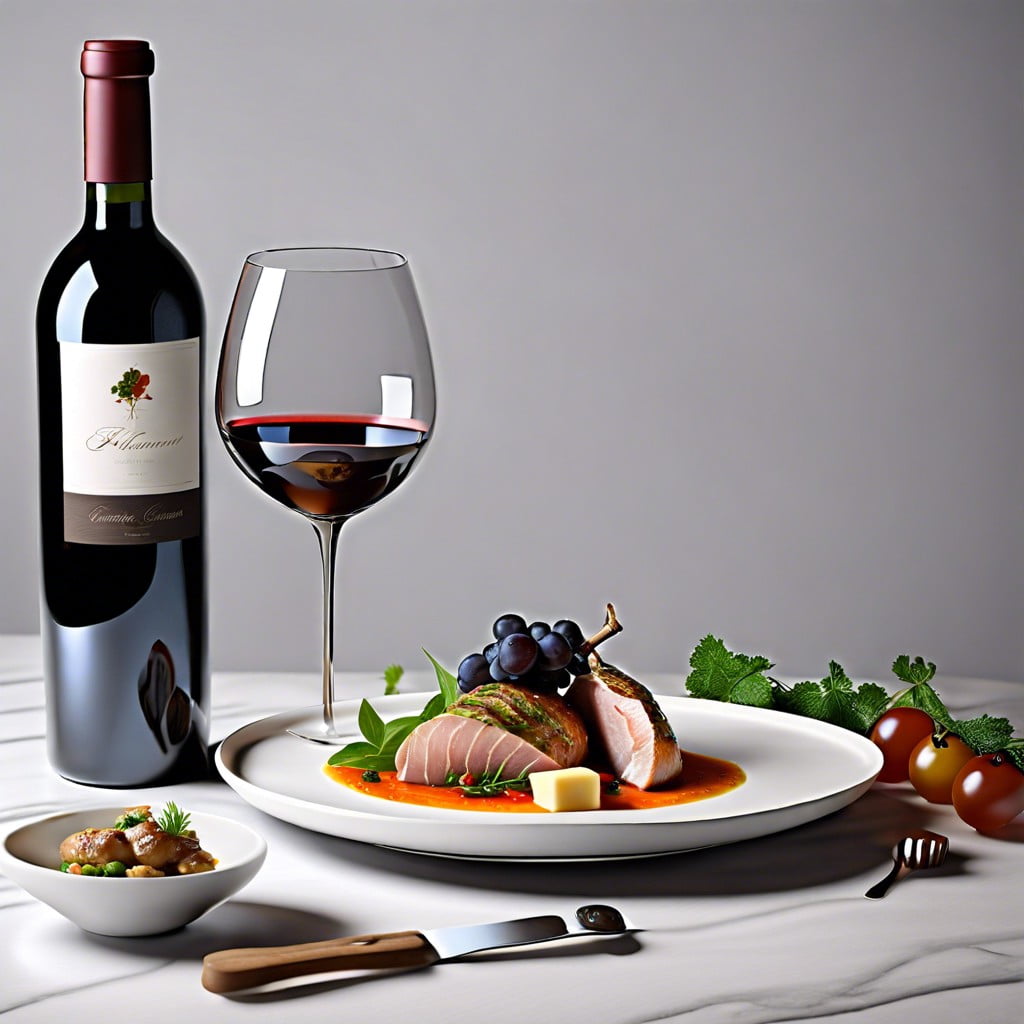Last updated on
Platings Pairings invites a gastronomic journey across great simple dishes flawlessly paired with exceptional wines, because nothing can elevate a meal quite like the perfect wine complement.
Key takeaways:
- Delicious simple dishes showcase the complexities of wine.
- Consider acidity, tannins, sweetness, body, and flavor profile when pairing wine.
- Simple recipes with fresh, high-quality ingredients make wine pairing easier.
- Expert tips: match weight, consider acidity, balance tannins, factor in sweetness, and regional pairings.
- Wine pairing basics: match intensity, factor in the sauce, consider acidity, play off main flavors, and balance tannins.
Delicious Simple Dishes

Focusing on dishes that require minimal effort and ingredients doesn’t mean sacrificing flavor or sophistication. Fresh, quality produce is key, as it brings out the best in any simple meal. Techniques like roasting or grilling can enhance natural flavors, creating a sumptuous base for the pairing experience. Seasonality is also important; incorporating ingredients at their peak ensures meals are delicious and full of flavor.
Moreover, the simplicity of a dish often highlights the wine’s complexities. A straightforward roasted chicken, for instance, can offer a canvas for a rich Chardonnay to shine. Meanwhile, a quick pasta tossed with olive oil, garlic, and fresh herbs serves as an ideal partner for a crisp Sauvignon Blanc.
Recipes with few components tend to have shorter preparation and cooking times, making them perfect for weeknight dinners or impromptu gatherings. Yet, these meals can be as comforting or as elegant as desired, adaptable to any occasion without overwhelming your palate prior to enjoying a well-matched glass of wine.
The Perfect Wine Pairings

Identifying the perfect wine to complement a dish hinges on understanding the balance between the flavors of the food and the characteristics of the wine. Here are some key points to consider in achieving a harmonious match:
- Acidity: Wines with higher acidity can enhance the flavors of a dish, especially those with fatty, creamy, or rich elements.
- Tannins: Red wines with notable tannins are best suited with protein-rich foods, as the tannins help to cleanse the palate after each bite.
- Sweetness: Sweeter wines complement foods with a spicy kick or with inherent sweetness, creating a balanced taste experience.
- Body: The body of the wine should match the weight of the dish; light dishes pair well with light-bodied wines, while heavy, robust dishes go well with full-bodied wines.
- Flavor Profile: Consider the dominant flavors in both the wine and the dish. Earthy wines can elevate similarly earthy dishes, while fruity wines might pair nicely with dishes that have a hint of sweetness or spice.
By keeping these principles in mind, you can elevate a simple meal into a memorable dining experience with a well-chosen wine pairing.
Simple and Easy-to-Follow Recipes
Creating dishes that are both uncomplicated and delectable is essential for any home cook looking to pair their meals with the right wine. To get started, focus on using fresh, high-quality ingredients – they are the foundation of any good dish.
Consider using herbs and spices to enhance the natural flavors without overwhelming them, making the pairing with wine more harmonious.
Emphasize techniques such as roasting or grilling to bring out the best in your ingredients. These methods tend to preserve the integrity of the food’s flavor, which can align nicely with the characteristics of various wine selections. For instance, the caramelization from roasting can complement the oaky notes in a Chardonnay.
Moreover, keep cooking steps to a minimum. Recipes with fewer procedures are not only quicker to prepare but also reduce the risk of introducing conflicting tastes that might clash with your wine. By focusing on simplicity, you’ll find it easier to match your culinary creations with the appropriate wines, resulting in a dining experience that is both exquisite and stress-free.
Expert Wine Recommendations
Navigating the vast world of wines need not be intimidating. Experts suggest starting with the basic principle that wines should complement, not compete with, the food on your plate. Here are a few key tips:
- Match the weight: Pair light dishes with light-bodied wines and hearty meals with fuller-bodied varieties.
- Consider acidity: Acidic wines can highlight the flavors in dishes such as salads with vinaigrettes or tomato-based sauces.
- Balance tannins: Tannic wines like Cabernet Sauvignon are excellent with fat-rich foods, as tannins cut through the richness and cleanse the palate.
- Sweetness for heat: If your dish has a spicy kick, a slightly sweet wine can provide a soothing contrast.
- Regional pairings: Often, wines from a specific region pair well with local cuisine.
Incorporate these recommendations when selecting a wine, and elevate an ordinary meal to a culinary experience.
Wine Pairing Guide
Understanding the basics of wine pairing enhances the dining experience. The underlying principle is balance; the wine should complement the flavors of the dish, not overpower it.
Consider the following when selecting a wine:
- Match the wine intensity with the food’s intensity. Lighter dishes, like a fresh salad, pair well with crisp white wines, whereas heavier dishes, such as a rich stew, call for a full-bodied red.
- Factor in the sauce. The dominant sauce in a dish can guide your wine choice. A creamy sauce might pair well with an oaked Chardonnay, while a tomato-based sauce might be better suited to a Sangiovese.
- Consider acidity. Foods with higher acidity can be balanced with wines that have a similar or slightly higher acidity, preventing the wine from tasting flat.
- Play off the dish’s main flavors. If a dish features earthy flavors, seek a wine that has notes of earthiness, such as a Pinot Noir.
- Don’t forget about tannins. Tannic wines, which can feel drying in the mouth, can be softened by pairing with fattier foods, which counterbalance the astringency.
- For spicy foods, opt for a wine with a touch of sweetness. A slightly sweet Riesling can mitigate the heat of a spicy dish.
By applying these points, you can enhance both the food and the wine, turning a good meal into a great culinary experience.
Perfect Wine Pairings for Every Meal
Understanding the balance between food flavors and wine characteristics enhances any dining experience. Consider the following points:
- 1. Acidity in wine pairs well with fatty and oily dishes, cutting through the richness of foods like salmon or creamy pasta sauces.
- 2. Tannic wines, such as Cabernet Sauvignon, complement red meats by balancing their protein structure and mitigating the perception of tannins.
- 3. Lighter wines like Pinot Noir or Chardonnay are versatile, matching well with poultry and light sauces, without overpowering the dish.
- 4. Sweet wines can counteract the heat of spicy food. A slightly sweet Riesling pairs delightfully with spicy Asian dishes, for instance.
- 5. Sparkling wines offer high acidity which is perfect for cleansing the palate, making them ideal for appetizers or fried foods.
Pairing the right wine with a meal is not just about red with meat and white with fish; it’s about harmonizing the elements of the dish with the qualities of the wine for a complementary and complete culinary experience.
Pairing Wines With Simple Dishes: Tips and Tricks
When marrying simple dishes with the right wine, achieving harmony between flavors is key. Here are some practical pointers to elevate your meal:
1. Match weight and intensity: Pair light dishes with light-bodied wines and heartier meals with a full-bodied selection. For instance, a zesty Sauvignon Blanc complements a fresh garden salad, while a robust Cabernet Sauvignon splendidly accompanies a rich lasagna.
2. Consider acidity: High-acid wines can be a delightful contrast to creamy or fatty foods. A crisp Pinot Grigio may offset the richness of a creamy Alfredo pasta, creating a balanced dining experience.
3. Balance sweetness and spiciness: Slightly sweet wines like Riesling can soothe the heat in spicy foods. A dish with a kick, such as spicy Thai noodles, can be tamed with a wine that has a hint of sugar.
4. Think about tannins: Tannins in wine can help cut through the fattiness of meats. A tannic wine like a Chianti will pair beautifully with a fatty cut of steak, as it cleanses the palate between bites.
5. Champion regional pairings: Often, regional cuisine and local wines are a natural fit. Chianti and Italian pasta, or a Californian Chardonnay with a San Francisco-style Cioppino, are classic examples of this symbiosis.
6. Wine as a flavor component: If a dish includes wine as an ingredient, it is a safe and often excellent choice to serve that same wine to drink. The flavors will inherently complement each other.
By applying these tips, you’ll not only enhance the taste of your meal but also deepen your understanding and enjoyment of wine pairings.
Minute Meals Pairings
For those pressed for time, pairing wines with 30-minute meals can transform a quick dinner into a gourmet experience.
- Speedy Pasta Dishes: A light-bodied white wine, such as Pinot Grigio, complements the freshness of a quick aglio e olio or a tangy puttanesca.
- Swiftly Sautéed Seafood: Match the delicate flavors of shrimp or scallops with the crisp acidity found in a Sauvignon Blanc.
- Quick-fix Grilled Chicken: A versatile Chardonnay pairs well with the smoky char and spices, enhancing the meal’s overall flavor without overpowering it.
- Fast Vegetarian Stir-Fries: Opt for a dry Riesling that can stand up to the bold flavors and textures, offering a palate-cleansing effect between bites.
- Express Tacos and Fajitas: A light red wine, such as Grenache, can hold its own against the spice and savor of Tex-Mex inspired dishes.
Remember, the key is to focus on the dominant flavors of the food and the body of the wine – a swift meal can still promise a rich and balanced dining experience.
Valentine’s Day Recipes Pairings
For a romantic Valentine’s Day meal, choosing the right wine to complement your dish can elevate the dining experience. A classic pairing is a silky Pinot Noir with a dish like duck breast or a hearty mushroom risotto.
Its versatile nature doesn’t overpower light meats yet has enough depth for richer flavors. If seafood is on the menu, a chilled glass of Chardonnay harmonizes beautifully with the delicate taste of scallops or lobster, especially if they’re prepared with creamy sauces.
For dessert, a sweet Moscato or a sparkling rosé pairs perfectly with chocolate-based confections or fresh strawberries, adding a bubbly, festive touch to the end of your meal.
Remember, the key to pairing is balance – the wine should complement, not compete with, your dish.




